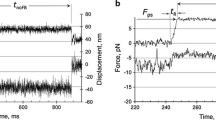Summary
A number of recent observations by probe and X-ray methods on the behaviour of crossbridges during contraction is considered in relation to the energetics of the process. It is shown that a self-consistent picture of the crossbridge cycle, compatible with these observations and involving strongly and weakly attached crossbridges, can be obtained providing that the tension-generating part of the crossbridge stroke is only about 40 Å i.e. about one-third of the usually accepted value. The myosin head subunits in the tension-generating bridges could have a configuration close to that of rigor. A mechanism is suggested whereby rapid tension recovery after quick releases up to 120 Å could still be produced by such a system.
Similar content being viewed by others
References
BRENNER, B., SCHOENBERG, M., CHALOVICH, J. M., GREEN, L. E. & EISENBERG, E. (1982) Evidence for cross-bridge attachment in relaxed muscle at low ionic strength.Proc. natn. Acad. Sci. U.S.A. 79, 7288–91.
BRENNER, B., YU, L. C. & PODOLSKY, R. J. (1984) X-ray diffraction evidence for crossbridge formation in relaxed muscle fibres at various ionic strengths.Biophys. J. 46, 299–306.
BURGHARDT, T. P., ANDO, T. & BOREJDO, J. (1983) Evidence of cross-bridge order in contraction of glycerinated skeletal muscle.Proc. natn. Acad. Sci. U.S.A. 80, 7515–19.
CHALOVICH, J. M. & EISENBERG, E. (1982) Inhibition of actomyosin ATPase activity by troponin—tropomyosin without blocking the binding of myosin to actin.J. biol. Chem. 257, 2432–7.
COOKE, R. & FRANKS, K. E. (1980) All myosin heads form bonds with actin in rigor rabbit skeletal muscle.Biochem. J. 19, 2265–9.
COOKE, R., CROWDER, M. S. & THOMAS, D. D. (1982) Orientation of spin labels attached to cross-bridges in contracting muscle fibres.Nature 300, 776–8.
COOKE, R., CROWDER, M. S., WENDT, C. H., BARNETT, V. A. & THOMAS, D. D. (1984) Muscle cross-bridges: do they rotate? InContractile Mechanisms in Muscle (edited by POLLACK, G. H. and SUGI, H.), pp. 413–23. New York, London: Plenum Press.
EISENBERG, E. & HILL, T. L. (1978) A crossbridge model of muscle contraction.Prog. biophys. molec. Biol. 33, 55–82.
FORD, L. E., HUXLEY, A. F. & SIMMONS, R. M. (1977) Tension responses to sudden length change in stimulated frog muscle fibres near slack length.J. Physiol. 269, 441–515.
FORD, L. E., HUXLEY, A. F. & SIMMONS, R. M. (1981) The relation between stiffness and filament overlap in stimulated frog muscle fibres.J. Physiol. 311, 219–49.
HASELGROVE, J. C. & HUXLEY, H. E. (1973) X-ray evidence for radial cross-bridge movement and for the sliding filament model in actively contracting skeletal muscle.J. molec. Biol. 77, 549–68.
HUXLEY, A. F. & SIMMONS, R. M. (1971) Proposed mechanism of force generation in striated muscle.Nature 133, 533–8.
HUXLEY, H. E. (1975) The structural basis of contraction and regulation in skeletal muscle.Acta anatomica nipponica 50, 310–25.
HUXLEY, H. E. (1979) Time resolved X-ray diffraction studies on muscle. InCrossbridge Mechanism in Muscle Contraction (edited by SUGI, H. and POLLACK, G. H.), pp. 391–405. Tokyo: University of Tokyo Press.
HUXLEY, H. E. (1980) The movement of myosin cross-bridges during contraction. InMuscle Contraction: its Regulatory Mechanisms (edited by EBASHI, S., MARUYAMA, K. and ENDO, M.), pp. 33–43. Tokyo: Japan Science Society Press, and Berlin: Springer-Verlag.
HUXLEY, H. E., FARUQI, A. R., KRESS, M., BORDAS, J. & KOCH, M. H. J. (1982) Time-resolved X-ray diffraction studies of the myosin layer-line reflections during muscle contraction.J. molec. Biol. 158, 637–84.
HUXLEY, H. E., SIMMONS, R. M., FARUQI, A. R., KRESS, M., BORDAS, J. & KOCH, M. H. J. (1983) Changes in the X-ray reflections from contracting muscle during rapid mechanical transients and their structural implications.J. molec. Biol. 169, 469–506.
HUXLEY, H. E., KRESS, M. & FARUQI, A. R. (1984). Time resolved X-ray diffraction measurements of the activation mechanism in striated muscle.Biophys. J. 45, 10a.
HUXLEY, H. E., KRESS, M. & SIMMONS, R. M. (1985) Time resolved X-ray diffraction studies of muscle activation and contraction.Biophys. J. 47, 24a.
KUSHMERICK, M. J. & DAVIES, R. E. (1969) The chemical energetics of muscle contraction.Proc. R. Soc. Ser. B.174, 315–53.
LOWELL, S. J. & HARRINGTON, W. F. (1981) Measurement of the fraction of myosin head bound to actin in rabbit skeletal myofibrils in rigor.J. molec. Biol. 149, 659–74.
MATSUBARA, I., YAGI, N., MIURA, H., OZEKI, M. & IZUMI, T. (1984) Intensification of the 5.9 mm actin layer line in contracting muscle.Nature 312, 417–73.
MATSUDA, T. & PODOLSKY, R. J. (1984) X-ray evidence for two structural states of the actomyosin cross-bridge in muscle fibers.Proc. natn. Acad. Sci. U.S.A. 81, 2364–8.
PODOLSKY, R. J., ST. ONGES, R., YU, L. & LYMN, R. W. (1976) X-ray diffraction of actively shortening muscle.Proc. natn. Acad. Sci. U.S.A. 73, 813–17.
STEIN, L. A., CHOCK, P. B. & EISENBERG, E. (1984) The rate-limiting step in the actomyosin adenosine triphosphatase cycle.Biochem. 23, 1555–63.
THOMAS, D. D. & COOKE, R. (1980) Orientation of spin-labeled myosin heads in glycerinated muscle fibers.Biophys. J. 32, 891–906.
YAGI, N., ITO, M. H., NAKAJIMA, H., IZUMI, T. & MATSUBARA, I. (1977) Return of myosin heads to thick filaments after muscle contraction.Science 197, 685–7.
YANAGIDA, T. (1981) Angles of nucleotides bound to cross-bridges in glycerinated muscle fibre at various concentrations of εATP, εADP, and εAMPPNP detected by polarized fluorescence.J. molec Biol. 146, 539–60.
Author information
Authors and Affiliations
Rights and permissions
About this article
Cite this article
Huxley, H.E., Kress, M. Crossbridge behaviour during muscle contraction. J Muscle Res Cell Motil 6, 153–161 (1985). https://doi.org/10.1007/BF00713057
Received:
Revised:
Issue Date:
DOI: https://doi.org/10.1007/BF00713057




